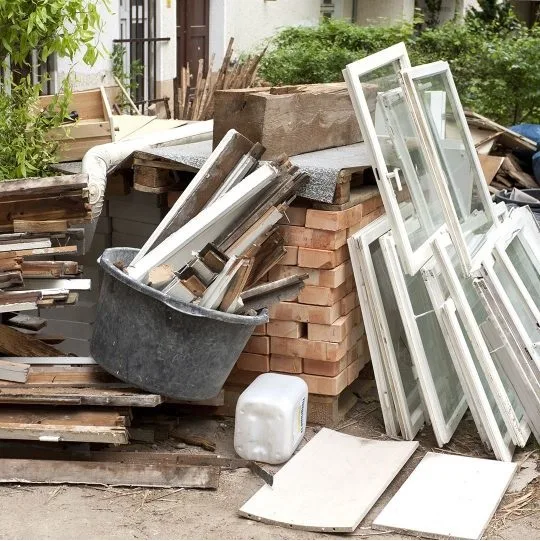As we journey towards a more eco-conscious world, the spotlight isn’t just on the way we construct our buildings, but also on how we manage the debris created in the process.
The strategic handling of trash isn’t just a mandatory task, it’s the backbone of sustainable building habits, minimizing our eco-footprint from new constructions and conserving precious resources.
In this engaging write-up, we’ll navigate through different techniques and tactics for managing waste efficiently, paving the way for more sustainable construction.
The Importance of Efficient Rubbish Removal in Construction Projects
Every year, the echo of hammers and saws at construction sites heralds not only new structures, but also heaps of waste that add weight to our planet’s waste management struggle.
A substantial fraction of this waste is classified as non-toxic solid rubbish. Nevertheless, if this isn’t carefully controlled, it can dig into the pocket and take a jab at the environment.
Stellar waste-management tactics aren’t a luxury, but a necessity for reaching green objectives throughout the lifespan of any construction project – from its conception to demolition or revamping.
By weaving effective rubbish removal methods, as taught by Dirt Cheap Rubbish Removal, into your construction sites’ fabric, you’re actively reducing your environmental footprint while sparing our world’s treasured trove of resources like energy and materials.
Fostering a Sustainable Approach through Waste Prevention and Reduction
One crucial step in promoting sustainable construction is preventing or reducing waste generation at its source. By adopting these practices early in your project planning phase, you can minimize the amount of rubbish generated on your construction site:
- Opt for prefabricated or modular building components that can be assembled off-site, thereby reducing waste generation at the construction site.
- Design and plan construction projects with a focus on minimizing material usage.
- Investigate innovative building materials and technologies that can help reduce waste production during construction.
- Purchase materials with minimal or reusable packaging to cut down on waste generation. Ensure stored materials are protected from weather elements to avoid spoilage and disposal.
Sustainable Waste Segregation Practices
Separating waste types on your construction site plays a crucial role in streamlining the recycling process and reducing contamination. Encourage proper onsite eco-friendly dumping of various waste types by allocating designated spaces for different categories of rubbish: this approach will significantly enhance your environmental impact control measures.
- Packaging materials like cardboard, plastic, paper, metal, etc., should be separated accordingly for easy recycling or reuse efforts.
- Inert waste such as crushed concrete, soil, rubble, etc., can be allocated to another designated area for potential recycling into secondary aggregates.
- Hazardous waste including asbestos, chemicals, paint tins should be stored separately from other rubbish categories according to local regulations. Ensure appropriate containment measures are adopted to prevent contamination risks from hazardous materials reaching other parts of the site or wider environment.
Take Advantage of Recycling Opportunities
After segregating the various waste types effectively on your construction site, it’s essential to identify opportunities to recycle or reuse as much material as possible.
Reusing materials not only assists in meeting sustainability targets but ensures cost savings while contributing towards reducing pressure on virgin resources:
- Metal cans and scrap metal can be easily recycled back into construction materials or new products.
- Gypsum plasterboard waste can be recycled into new plasterboard, reducing reliance on natural gypsum resources.
- Wooden pallets and other wood wastes can be repurposed as mulch, particle board, or even used for biomass energy production.
- Inert waste materials like crushed concrete and brick can be utilized as a sub-base material in road construction, replacing the use of primary aggregates from quarries.
Dirt Cheap Rubbish Removal: Find the Right Waste Management Partner
Finding the right waste management company is essential to ensure efficient rubbish removal for your sustainable construction projects.
Choose a service provider that shares your commitment towards sustainability and has a solid track record in managing construction waste responsibly.
A reputable waste management partner should offer services such as:
- Site evaluation and tailored solutions to suit your specific project needs
- Transparent pricing options without hidden charges
- Prompt, reliable collection services that work around your schedule
- Comprehensive recycling solutions to maximize the potential of recovered materials
- Reporting data on waste disposal and recovery rates to help you measure progress against sustainability objectives
- Continuous improvement initiatives aimed at refining their service offerings for increasingly sustainable results
A minimum reduction of 50% waste by the year 2020 compared to traditional UK practices. Waste is carefully segregated into different streams and sent to nearby recycling facilities where possible, reducing transportation distances for waste disposal and minimizing overall carbon footprint associated with the project.
Conclusion
To achieve efficient rubbish removal for sustainable construction, you must adopt a proactive approach that revolves around reducing waste generation, implementing effective segregation practices, maximizing recycling opportunities, and partnering with a committed waste management service provider. These measures play an essential role in promoting resource conservation while contributing towards a greener environment and more sustainable future for generations to come.



